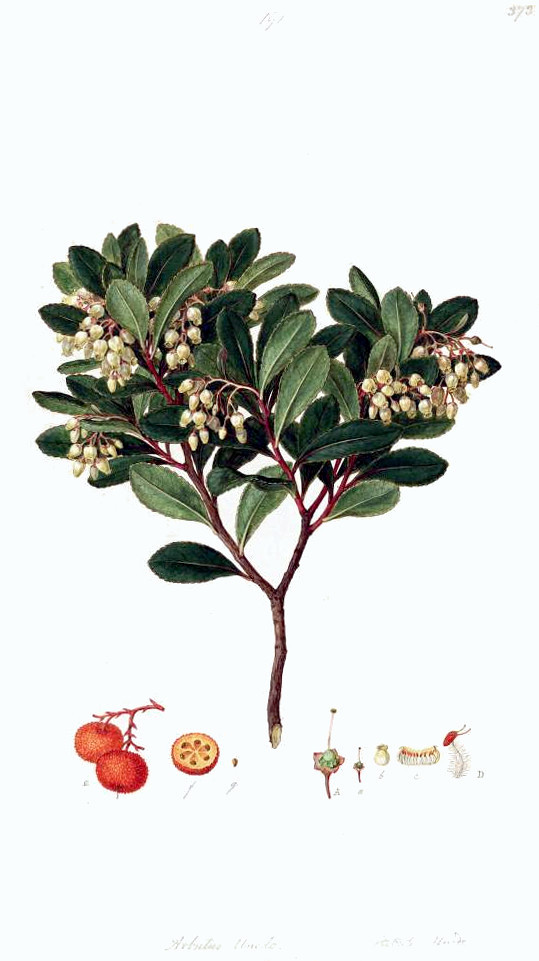Arbutus unedo L. - Ericaceae - syn. Arbutus serratifolia Salisb., Arbutus crispa Hoffm.; strawberry tree, Westlicher Erdbeerbaum
Beautiful Mediterranean evergreen shrub or tree, 2-3(-10)m, in culture usually 5m or less; bark red-brown; leaves alternate, oblong to obovate, tapering at both ends, serrate, dark shining green; flowers urn-shaped, greenish white to pinkish, about 6-8 mm long; terminal nodding panicles about 5 cm long; berry spherical, first green then yellow, scarlet when mature, warty, 1.5-2 cm across, „strawberry-like“.
The bark, containing up to 45% tannin, is used to tan lether. [CRC]
The main components of the volatiles of A. unedo fruits are alcohols, followed by aldehydes and esters. The main volatile compounds identified were (Z)-3-hexen-1-ol, 1-hexanol, hexanal, (E)-2-hexenal, and (Z)-3-hexenyl acetate, all with green odors. These are decreased in fully ripening state and mixed up with floral (linalool, α-terpineol) and sweet-waxy (methyl decanoate, mehtyl dodecanoate, ethyl dodecanoate) sensations.
[Volatile profile of Arbutus unedo L. fruits through ripening stage., Oliveira, I., de Pinho, P.G., Malheiro, R., Baptista, P., Pereira, J.A., Food Chemistry, 128(3), 2011, 667-673]
„… fruits of A. unedo are rarely eaten as fresh fruit as despite their pleasing appearance, the taste is not much appreciated by the consumer. So far, they are generally used for obtaining alcoholic drinks (wines, liqueurs and brandies), jams, jellies and marmalades. They can also be incorporated into yoghurts either in pieces or as flavours and be used, like other berries in confectionery such as pie and pastry fillings, cereal products, among other applications…
Strawberry tree honey is a known product of Mediterranean regions which is characterized for its “bitter taste”. Homogentisic acid (2,5-dihydroxyphenylacetic) has been considered as a chemical marker of the botanical origin of strawberry tree honey along with (±)-2-cis,4-trans-abscisic acid (c,t-ABA), (±)-2-trans, 4-trans-abscisic acid (t,t-ABA) and unedone. From the aromatic profile of strawberry tree honey from Sardinia (Italy) and Canary islands (Spain) some authors reported that norisoprenoids such as α-isophorone, β-isophorone and 4-oxoisophorone could be considered specific floral origin markers. “
[Arbutus unedo L.: Chemical and biological properties., Miguel, M.G., Faleiro, M.L., Guerreiro, A.C., Antunes, M.D., Molecules, 19(10), 2014, 15799-15823] http://www.mdpi.com/1420-3049/19/10/15799/htm
The dried leaves of Arbutus unedo, (Arbutus unedo leaves, Arbute leaves, Folia Arbuti, Erdbeerbaumblätter) contain the phenolglucosides arbutin (3%) and methylarbutin. Also present are flavonolglucosides, derived from kaempferol like juglanin (kaempferol-3-arabinoside) and avicularin (kaempferol-3-arabinofuranoside) or derived from quercetin like hyperoside (quercetin-3-galactoside); furthermore iridoidglucosides (unedoside as main glucoside, 0.2%) and tannin. Leave extracts are antibiotic and astringent, they are used as urinary desinfectant and for diarrhea.
[Hager; CRC; Rimpler H, Pistor H, Z. Naturf. C, 29, (1974), 368]
„The leaves of Arbutus unedo L. are used as a urinary antiseptic, against diabetes, an antidiarrheal adstringent, depurative, antioxidant and as an antihypertensive. Chemical investigations of leaves and fruits indicated the presence of the essential oil, flavonoids, proanthocyanidins, iridoids glucosides, sugars non-volatile and phenolic acids and tocopherol.“
[Identification of Phenolic Compounds and Antimicrobial Activity of Roots of Arbutus unedo L., M.A. Dib N. Djabou, H. Allali and B. Tabti, Asian Journal of Chemistry Vol. 22, No. 5 (2010), 4045-4053]
„Ethanol extracts of A. unedo leaves were the highest in reducing power (IC50 232.7µg/mL) and DPPH scavenging effect (IC 50 63.2 µg/mL) followed by water extracts (with IC50 of 287.7 and 73.7 µg/mL, respectively)… The results indicated that A. unedo leaves are a potential source of natural antioxidants.“
[Scavenging capacity of strawberry tree (Arbutus unedo L.) leaves on free radicals. Ivo Oliveira, Valentim Coelho, Raquel Baltasar, José Alberto Pereira, Paula Baptista, Food and Chemical Toxicology 47 (2009) 1507–1511] https://bibliotecadigital.ipb.pt/bitstream/10198/3106/3/60%20resumo.pdf

Sibthrop, J., Smith, J.E., Flora Graeca (drawings), vol.4, t.73 (1823)
http://plantgenera.org/species.php?id_species=79712
Arbutus unedo, Palmenhaus Schönbrunn
© Rolf Marschner (2016),
www.botanische-spaziergaenge.at